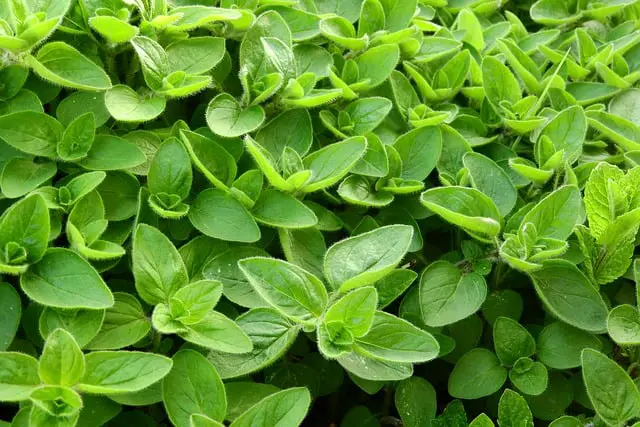Marjoram is a fragrant, herbaceous plant that is native to the Mediterranean region and is a member of the mint family. While it is a herb, it is widely used in conjunction with spices in many dishes, too.
In terms of taste, marjoram has a slightly sweet and pine-like and citrusy flavor that is similar to oregano, but milder and sweeter. It is commonly used as a dried herb or as fresh leaves in cooking. As such, it can be used to bring out the aromatics of soups and stews, or enhance seasonal veggies, fruits, and other dishes.
What makes marjoram so useful
Marjoram is a pungent, sweet herb and a close relative of oregano. It has an intense and slightly bitter-sweet flavor that enhances a variety of savory dishes, from salads to soups and roasts. The herb can be used both fresh and dried in cooking but it is especially popular in Mediterranean, Middle Eastern, and Asian cuisines.
As the marjoram plant matures, the tiny leaves become more aromatic and flavorful which creates the perfect addition to any dish. In fact, many cultures have realized this and use it in their own cuisines alongside many other herbs and spices.
Italian cuisine typically includes the use of marjoram alongside oregano, basil, and other herbs. It is an essential ingredient in many classic Italian dishes such as pasta sauces, stews, braised meats, and vegetable dishes.
In Greek and Middle Eastern countries, marjoram can be found in many different dishes. It is often used as a seasoning for soups, meats, and even pickles. Marjoram is most commonly used alongside oregano, parsley and basil to create flavor profiles that are truly unique to this region of the world.
Marjoram isn’t just used in recipes; it also has a few medicinal uses. The herb can be made into teas that are believed to help with digestive problems, promote relaxation, and reduce inflammation. In addition, records show that ancient Egyptians took marjoram supplements as a form of natural medicine.
Today, the herb is commonly found in capsule and tincture forms at health food stores and can be beneficial for those looking to incorporate herbal remedies into their daily routines.
Marjoram is used in a number of cultures
Marjoram is a popular herb used in many different cultures around the world. Here are a few examples of how it is used:
- Mediterranean: Marjoram is commonly used in Mediterranean cuisine for seasoning meat dishes such as grilled lamb, chicken and beef.
- Middle Eastern: Marjoram is a staple in Middle Eastern cuisine and is used in spice blends like za’atar and baharat, as well as in dishes like kebabs and stews.
- European: In Europe, marjoram is often used in stuffings, soups, and stews, as well as in sauces for poultry and game.
- American: In the United States, marjoram is commonly used in hearty meat dishes like meatloaf and roasted chicken, as well as in herb blends for grilling and barbecue.
- Mexican: Marjoram is also used in Mexican cuisine, typically in seasoning blends for tacos and other traditional dishes.
Note: The use of marjoram can vary greatly depending on local cuisine, but these are some common examples of its usage in different cultures.
What spices are used in conjunction with marjoram?
Marjoram is a versatile herb that can be paired with a variety of spices to enhance flavor. Here are some common spices (and other herbs) used in conjunction with marjoram:
- Garlic: Marjoram and garlic make a classic flavor pairing, used together in many Mediterranean and European dishes.
- Thyme: Marjoram and thyme are both herbs often used in soups, stews, and sauces.
- Rosemary: Marjoram and rosemary are both woody, fragrant herbs that are commonly used together in meat dishes and roasted vegetables.
- Sage: Marjoram and sage are both earthy herbs that are often used together in stuffing, sauces, and slow-cooked dishes.
- Oregano: Marjoram and oregano are both herbs from the mint family and share similar flavor profiles. They are often used together in Mediterranean and Mexican cuisine.
- Paprika: Marjoram can be paired with spicy paprika to add heat to dishes like soups and stews.
- Bay leaves: Marjoram can be used with bay leaves in soups, stews, and braised dishes for a warm, herbal flavor.
7 popular dishes that incorporate marjoram
Unlock the subtle, floral flavors of marjoram by incorporating it into more than just your traditional dishes.
Here are 7 specific dishes where marjoram can be used:
- Roasted vegetables: Use marjoram to season vegetables like potatoes, carrots, and Brussels sprouts before roasting in the oven.
- Meat dishes: Marjoram is a great addition to meat dishes like roasted chicken, pork chops, and beef stews.
- Soups: Marjoram can be added to soups like tomato or minestrone for extra flavor.
- Salad dressings: Mix marjoram with olive oil, lemon juice, and garlic to make a flavorful salad dressing.
- Sauces: Marjoram can be used in sauces for pasta, meats, and vegetables.
- Grilled dishes: Marjoram is a great herb for grilling and can be used to season meats, seafood, and vegetables.
- Omelets and scrambled eggs: Add marjoram to scrambled eggs or omelets for extra flavor.
How to store marjoram for a longer shelf life
To make the most out of your marjoram, store it in a cool, dark place. The shelf-life of marjoram depends on the form in which it is used; either fresh or dried. Fresh marjoram should be stored in an airtight container in the refrigerator and can last for up to 4 weeks.
For maximum potency and taste, however, use it as soon as possible after purchase. Dried marjoram should be stored in an airtight jar away from light and heat but not necessarily in the fridge. If properly stored, dried marjoram will keep for 6 months to 1 year.

